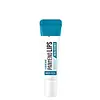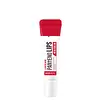What's inside
What's inside
 Key Ingredients
Key Ingredients

 Benefits
Benefits

 Concerns
Concerns

 Ingredients Side-by-side
Ingredients Side-by-side

Polybutene
Paraffinum Liquidum
EmollientCaprylic/Capric Triglyceride
MaskingEthylene/Propylene/Styrene Copolymer
Butylene/Ethylene/Styrene Copolymer
Olea Europaea Fruit Oil
MaskingHelianthus Annuus Seed Oil
EmollientMacadamia Integrifolia Seed Oil
Skin ConditioningButyrospermum Parkii Butter
Skin ConditioningArgania Spinosa Kernel Oil
EmollientAlcohol
AntimicrobialCetearyl Olivate
Sorbitan Olivate
EmulsifyingTocopheryl Acetate
AntioxidantParfum
MaskingBHT
AntioxidantPanthenol
Skin ConditioningCI 45410
Cosmetic ColorantPolybutene, Paraffinum Liquidum, Caprylic/Capric Triglyceride, Ethylene/Propylene/Styrene Copolymer, Butylene/Ethylene/Styrene Copolymer, Olea Europaea Fruit Oil, Helianthus Annuus Seed Oil, Macadamia Integrifolia Seed Oil, Butyrospermum Parkii Butter, Argania Spinosa Kernel Oil, Alcohol, Cetearyl Olivate, Sorbitan Olivate, Tocopheryl Acetate, Parfum, BHT, Panthenol, CI 45410
Water
Skin ConditioningPanthenol
Skin ConditioningSorbitol
HumectantIsohexadecane
EmollientCaprylic/Capric Triglyceride
MaskingGlycerin
HumectantDilinoleic Acid/Propanediol Copolymer
EmollientCetearyl Alcohol
EmollientDiisostearyl Malate
EmollientMacadamia Ternifolia Seed Oil
EmollientPEG/PPG-17/6 Copolymer
SolventPhytosteryl Sunflowerseedate
Skin ConditioningBeeswax
Emulsion StabilisingPolysorbate 60
EmulsifyingGlyceryl Stearate
EmollientMethyl Glucose Sesquistearate
EmollientSorbitan Sesquioleate
EmulsifyingHydrogenated Vegetable Glycerides
EmollientDimethicone
Emollient1,2-Hexanediol
Skin ConditioningTocopheryl Acetate
AntioxidantPEG-100 Stearate
Arginine
MaskingCarbomer
Emulsion StabilisingButylene Glycol
HumectantCaprylhydroxamic Acid
Sodium Acrylate/Sodium Acryloyldimethyl Taurate Copolymer
Emulsion StabilisingAllantoin
Skin ConditioningParfum
MaskingPolysorbate 80
EmulsifyingDisodium EDTA
Sodium Hyaluronate
HumectantHelianthus Annuus Seed Oil
EmollientOlea Europaea Fruit Oil
MaskingArgania Spinosa Kernel Oil
EmollientSorbitan Oleate
EmulsifyingWater, Panthenol, Sorbitol, Isohexadecane, Caprylic/Capric Triglyceride, Glycerin, Dilinoleic Acid/Propanediol Copolymer, Cetearyl Alcohol, Diisostearyl Malate, Macadamia Ternifolia Seed Oil, PEG/PPG-17/6 Copolymer, Phytosteryl Sunflowerseedate, Beeswax, Polysorbate 60, Glyceryl Stearate, Methyl Glucose Sesquistearate, Sorbitan Sesquioleate, Hydrogenated Vegetable Glycerides, Dimethicone, 1,2-Hexanediol, Tocopheryl Acetate, PEG-100 Stearate, Arginine, Carbomer, Butylene Glycol, Caprylhydroxamic Acid, Sodium Acrylate/Sodium Acryloyldimethyl Taurate Copolymer, Allantoin, Parfum, Polysorbate 80, Disodium EDTA, Sodium Hyaluronate, Helianthus Annuus Seed Oil, Olea Europaea Fruit Oil, Argania Spinosa Kernel Oil, Sorbitan Oleate
 Reviews
Reviews

Ingredients Explained
These ingredients are found in both products.
Ingredients higher up in an ingredient list are typically present in a larger amount.
You may know this ingredient as argan oil. Argan Oil has antioxidant, hydrating, and soothing properties.
Studies have shown argan oil can help fight again radical damage from the sun. This makes it effective at preventing hyperpigmentation.
Large amounts of vitamin E found in argan oil helps the skin retain water. Argan oil also contains fatty acids such as linoleic acid, oleic acid, and palmitic acid. It is also a good source of lipids.
Another benefit of argan oil is skin-soothing. It can help reduce inflammation-related skin symptoms.
Argan Oil is effective at regulating sebum production in pores. This can make it effective at treating hormonal acne.
Traditionally, argan oil was used for its antibacterial and antifungal properties. However, argan oil contains fatty acids that may make it not fungal-acne safe.
Argan Trees are native to Morocco.
Learn more about Argania Spinosa Kernel OilThis ingredient is an emollient, solvent, and texture enhancer. It is considered a skin-softener by helping the skin prevent moisture loss.
It helps thicken a product's formula and makes it easier to spread by dissolving clumping compounds.
Caprylic Triglyceride is made by combining glycerin with coconut oil, forming a clear liquid.
While there is an assumption Caprylic Triglyceride can clog pores due to it being derived from coconut oil, there is no research supporting this.
Learn more about Caprylic/Capric TriglycerideHelianthus Annuus Seed Oil is the oil derived from the seeds of a Sunflower. Sunflower seed oil is non-fragrant. It is an emollient, meaning it helps to soften the skin.
Sunflower seed oil contains many fatty acids. The fatty acids found in sunflower seeds include (from highest amount to least): linoleic acid, myristic acid, palmitic acid, stearic acid, arachidic acid, oleic acid, and linolenic acid.
These fatty acids help the skin create ceramides. Ceramides play a role in repairing the skin barrier.
Helianthus Annuus Seed Oil helps moisturize the skin. This in turn helps the skin look more rejuvenated and smoother.
Sunflowers are rich in vitamin E.
Historians believe Indigenous cultures of North America domesticated sunflowers before corn. Thus they relied on sunflower oil for a variety of uses. One such use is moisturizing skin and hair.
Sunflower seed oil may not be fungal acne safe. We recommend speaking with a professional if you have any concerns.
Learn more about Helianthus Annuus Seed OilOlea Europaea Fruit Oil is the fixed oil obtained from the ripe fruit of the Olive. In other words - olive oil.
The primary contents of olive oil are glycerides of the fatty acids linoleic, oleic and palmitic.
Olive oil also contains antioxidants such as Vitamin E. Antioxidants may help reduce signs of aging by fighting unstable free-radical molecules. It also contains Vitamins A (retinol), D, and K.
The squalene in olive oil makes it a great emollient. Emollients help soothe and soften your skin by trapping moisture in. This makes olive oil a great skin moisturizer.
Studies show olive oil to have antibacterial and antifungal properties in low concentrations. Another study found olive oil irritated sensitive oily skin. We always recommend speaking with a professional about using this ingredient in your routine.
Due to the fatty acid content, this ingredient may not be fungal-acne safe.
Learn more about Olea Europaea Fruit OilPanthenol is a common ingredient that helps hydrate and soothe the skin. It is found naturally in our skin and hair.
There are two forms of panthenol: D and L.
D-panthenol is also known as dexpanthenol. Most cosmetics use dexpanthenol or a mixture of D and L-panthenol.
Panthenol is famous due to its ability to go deeper into the skin's layers. Using this ingredient has numerous pros (and no cons):
Like hyaluronic acid, panthenol is a humectant. Humectants are able to bind and hold large amounts of water to keep skin hydrated.
This ingredient works well for wound healing. It works by increasing tissue in the wound and helps close open wounds.
Once oxidized, panthenol converts to pantothenic acid. Panthothenic acid is found in all living cells.
This ingredient is also referred to as pro-vitamin B5.
Learn more about PanthenolParfum is a catch-all term for an ingredient or more that is used to give a scent to products.
Also called "fragrance", this ingredient can be a blend of hundreds of chemicals or plant oils. This means every product with "fragrance" or "parfum" in the ingredients list is a different mixture.
For instance, Habanolide is a proprietary trade name for a specific aroma chemical. When used as a fragrance ingredient in cosmetics, most aroma chemicals fall under the broad labeling category of “FRAGRANCE” or “PARFUM” according to EU and US regulations.
The term 'parfum' or 'fragrance' is not regulated in many countries. In many cases, it is up to the brand to define this term.
For instance, many brands choose to label themselves as "fragrance-free" because they are not using synthetic fragrances. However, their products may still contain ingredients such as essential oils that are considered a fragrance by INCI standards.
One example is Calendula flower extract. Calendula is an essential oil that still imparts a scent or 'fragrance'.
Depending on the blend, the ingredients in the mixture can cause allergies and sensitivities on the skin. Some ingredients that are known EU allergens include linalool and citronellol.
Parfum can also be used to mask or cover an unpleasant scent.
The bottom line is: not all fragrances/parfum/ingredients are created equally. If you are worried about fragrances, we recommend taking a closer look at an ingredient. And of course, we always recommend speaking with a professional.
Learn more about ParfumTocopheryl Acetate is AKA Vitamin E. It is an antioxidant and protects your skin from free radicals. Free radicals damage the skin by breaking down collagen.
One study found using Tocopheryl Acetate with Vitamin C decreased the number of sunburned cells.
Tocopheryl Acetate is commonly found in both skincare and dietary supplements.
Learn more about Tocopheryl Acetate